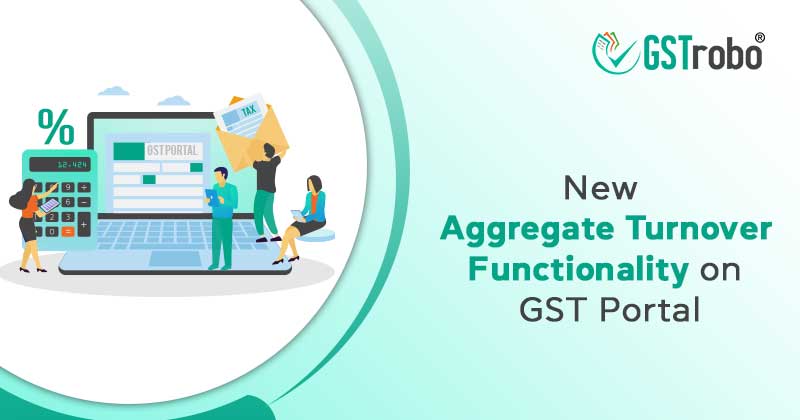New Aggregate Turnover Functionality on GST Portal
In GST, the term “aggregate turnover” is quite crucial as it determines:
- Whether a person is required to obtain GST registration?
- If a person entitled to enroll in the Composition Scheme?
- Whether a business must file GSTR-9 and GSTR-9C or not?

- What is Annual Aggregate Turnover (AATO)?
- GST Registration Criteria Based on Annual Aggregate Turnover (AATO)
- AATO Threshold Limit for the Special Category States
- How to Determine Annual Aggregate Turnover (AATO)?
- New Annual Aggregate Turnover Functionality on GST Portal
- How to View or Update Aggregate Turnover on GST Portal?
What is Annual Aggregate Turnover (AATO)?
The term “aggregate turnover” is defined in the GST law as “the value of all taxable supplies (excluding reverse charge purchases), exempt supplies, export of goods or/and services, and interstate supply of persons having the same permanent account number, to be determined on a pan-India basis, but excluding CGST, SGST, UTGST, IGST, and CESS. And annual aggregate turnover is the total turnover computed for the entire financial year from April to March of the financial year.
GST Registration Criteria Based on Annual Aggregate Turnover (AATO)
According to GST law, a business whose aggregate turnover in a financial year (FY) exceeds INR 40 lakhs for goods and INR 20 lakhs for services (AATO threshold limit for special category state is discussed in the latter section of this blog) must register itself under Goods and Service Tax in its State or UT.
AATO Threshold Limit for the Special Category States
The following is a list of states that have been granted special status under the GST Act:
- Assam
- J&K
- Manipur
- Mizoram
- Meghalaya
- Sikkim
- Himachal Pradesh
- Arunachal Pradesh
- Uttarakhand
- Nagaland
- Tripura
On the request of a special category State and the GST Council’s recommendation, the Government may increase the aggregate turnover referred to in the law from INR 10 Lakhs to such levels as may be prescribed in the CGST (Amendment) Act, 2018. As a result, from January 1, 2019, the threshold limit for special category states increased to INR 20 lakhs for goods and INR 10 lakhs for services.
How to Determine Annual Aggregate Turnover (AATO)?
Let us understand this with an example:
XYZ Pvt. Ltd., based in Haryana, is a manufacturing company. In Maharashtra and Rajasthan, they have units. The following table provides further information:
| Business Unit of | PAN | Unit Location | Turnover (INR) |
| XYZ Pvt. Ltd | XXXXXX2345 | Haryana | 31,00,000 |
| XYZ Pvt. Ltd | XXXXXX2345 | Maharashtra | 10,00,000 |
| XYZ Pvt. Ltd | XXXXXX2345 | Rajasthan | 9,00,000 |
Because all three units are registered under the same PAN, the turnover of all three units in Delhi, Maharashtra, and Rajasthan will be included in the Aggregate Turnover calculation. As a result of this, XYZ Pvt. Ltd. will be required to obtain GST registration because its aggregate turnover is INR 50 lakhs.
New Annual Aggregate Turnover Functionality on GST Portal
- The GSTN has added a new feature to the dashboards of taxpayers. Taxpayers can now see the exact Annual Aggregate Turnover (AATO) for the previous FY. Taxpayers can also view the current fiscal year’s aggregate turnover based on GST returns filed by them.
- Furthermore, taxpayers now have the option of updating their turnover if they believe the system-calculated turnover presented on their dashboard differs from the turnover recorded in their records.
- All GSTINs registered on the same PAN will have access to this turnover updating facility. For calculating Annual Aggregate Turnover, all changes in turnover by any of the GSTINs will be added together.
- The taxpayer can change the turnover thrice in a month from the date of implementation of this functionality. Thereafter, the updated turnover value will freeze with no further attempts to update turnover(s).
- The data will then be reviewed by the jurisdictional tax officer, who then can change the aggregate turnover values provided by the taxpayer. Such an officer will communicate with the taxpayer before amending the turnover declared by the taxpayer. In case no action is taken by the officer within 30 days of the turnover reported by the taxpayer, the same shall be considered final.
Note: In case of any grievance relating to this functionality, the aggrieved taxpayer can raise a ticket at https://selfservice.gstsystem.in
How to View or Update Aggregate Turnover on GST Portal?
Step 1: Log in to the GST Portal
Step 2: Once logged in click on the Continue to Dashboard.
Step 3: A new page will open showing the turnover details.
Step 4: Now click on the View/Update.
